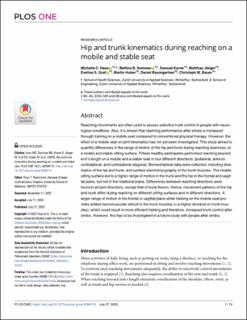Please use this identifier to cite or link to this item:
https://doi.org/10.21256/zhaw-28446Full metadata record
| DC Field | Value | Language |
|---|---|---|
| dc.contributor.author | Haas, Michelle | - |
| dc.contributor.author | Sommer, Bettina | - |
| dc.contributor.author | Karrer, Samuel | - |
| dc.contributor.author | Jörger, Matthias | - |
| dc.contributor.author | Graf, Eveline | - |
| dc.contributor.author | Huber, Martin | - |
| dc.contributor.author | Baumgartner, Daniel | - |
| dc.contributor.author | Bauer, Christoph | - |
| dc.date.accessioned | 2023-08-11T10:21:42Z | - |
| dc.date.available | 2023-08-11T10:21:42Z | - |
| dc.date.issued | 2023-07-27 | - |
| dc.identifier.issn | 1932-6203 | de_CH |
| dc.identifier.uri | https://digitalcollection.zhaw.ch/handle/11475/28446 | - |
| dc.description.abstract | Reaching movements are often used to assess selective trunk control in people with neurological conditions. Also, it is known that reaching performance after stroke is increased through training on a mobile seat compared to conventional physical therapy. However, the effect of a mobile seat on joint kinematics has not yet been investigated. This study aimed to quantify differences in the range of motion of the hip and trunk during reaching exercises on a mobile and stable sitting surface. Fifteen healthy participants performed reaching beyond arm's length on a mobile and a stable seat in four different directions: ipsilateral, anterior, contralateral, and contralateral diagonal. Biomechanical data were collected, including kinematics of the hip and trunk, and surface electromyography of the trunk muscles. The mobile sitting surface led to a higher range of motion in the trunk and the hip in the frontal and sagittal plane, but not in the rotational plane. Differences between reaching directions were found in all joint directions, except that of trunk flexion. Hence, movement patterns of the hip and trunk differ during reaching on different sitting surfaces and in different directions. A larger range of motion in the frontal or sagittal plane while training on the mobile seat provides added neuromuscular stimuli to the trunk muscles (= a higher demand on trunk muscles), which could result in more efficient training and therefore, increased trunk control after stroke. However, this has to be investigated in a future study with people after stroke. | de_CH |
| dc.language.iso | en | de_CH |
| dc.publisher | Public Library of Science | de_CH |
| dc.relation.ispartof | PLOS ONE | de_CH |
| dc.rights | http://creativecommons.org/licenses/by/4.0/ | de_CH |
| dc.subject | Kinematics | de_CH |
| dc.subject | Reaching | de_CH |
| dc.subject | Mobile seat | de_CH |
| dc.subject | Stable seat | de_CH |
| dc.subject | Hip | de_CH |
| dc.subject | Trunk | de_CH |
| dc.subject.ddc | 615.82: Physiotherapie | de_CH |
| dc.subject.ddc | 616.8: Neurologie und Krankheiten des Nervensystems | de_CH |
| dc.title | Hip and trunk kinematics during reaching on a mobile and stable seat | de_CH |
| dc.type | Beitrag in wissenschaftlicher Zeitschrift | de_CH |
| dcterms.type | Text | de_CH |
| zhaw.departement | Gesundheit | de_CH |
| zhaw.departement | School of Engineering | de_CH |
| zhaw.organisationalunit | Institut für Mechanische Systeme (IMES) | de_CH |
| zhaw.organisationalunit | Institut für Physiotherapie (IPT) | de_CH |
| dc.identifier.doi | 10.1371/journal.pone.0289115 | de_CH |
| dc.identifier.doi | 10.21256/zhaw-28446 | - |
| dc.identifier.pmid | 37498910 | de_CH |
| zhaw.funding.eu | No | de_CH |
| zhaw.issue | 7 | de_CH |
| zhaw.originated.zhaw | Yes | de_CH |
| zhaw.pages.start | e0289115 | de_CH |
| zhaw.publication.status | publishedVersion | de_CH |
| zhaw.volume | 18 | de_CH |
| zhaw.publication.review | Peer review (Publikation) | de_CH |
| zhaw.webfeed | BME Biomechanical Engineering | de_CH |
| zhaw.funding.zhaw | Holoreach | de_CH |
| zhaw.author.additional | No | de_CH |
| zhaw.display.portrait | Yes | de_CH |
| zhaw.relation.references | https://doi.org/10.7910/DVN/LP3W8J | de_CH |
| Appears in collections: | Publikationen Gesundheit | |
Files in This Item:
| File | Description | Size | Format | |
|---|---|---|---|---|
| 2023_Haas-etal_Hip-trunk-kinematics-during-reaching.pdf | 1.22 MB | Adobe PDF |  View/Open |
Show simple item record
Haas, M., Sommer, B., Karrer, S., Jörger, M., Graf, E., Huber, M., Baumgartner, D., & Bauer, C. (2023). Hip and trunk kinematics during reaching on a mobile and stable seat. Plos One, 18(7), e0289115. https://doi.org/10.1371/journal.pone.0289115
Haas, M. et al. (2023) ‘Hip and trunk kinematics during reaching on a mobile and stable seat’, PLOS ONE, 18(7), p. e0289115. Available at: https://doi.org/10.1371/journal.pone.0289115.
M. Haas et al., “Hip and trunk kinematics during reaching on a mobile and stable seat,” PLOS ONE, vol. 18, no. 7, p. e0289115, Jul. 2023, doi: 10.1371/journal.pone.0289115.
HAAS, Michelle, Bettina SOMMER, Samuel KARRER, Matthias JÖRGER, Eveline GRAF, Martin HUBER, Daniel BAUMGARTNER und Christoph BAUER, 2023. Hip and trunk kinematics during reaching on a mobile and stable seat. PLOS ONE. 27 Juli 2023. Bd. 18, Nr. 7, S. e0289115. DOI 10.1371/journal.pone.0289115
Haas, Michelle, Bettina Sommer, Samuel Karrer, Matthias Jörger, Eveline Graf, Martin Huber, Daniel Baumgartner, and Christoph Bauer. 2023. “Hip and Trunk Kinematics during Reaching on a Mobile and Stable Seat.” Plos One 18 (7): e0289115. https://doi.org/10.1371/journal.pone.0289115.
Haas, Michelle, et al. “Hip and Trunk Kinematics during Reaching on a Mobile and Stable Seat.” Plos One, vol. 18, no. 7, July 2023, p. e0289115, https://doi.org/10.1371/journal.pone.0289115.
Items in DSpace are protected by copyright, with all rights reserved, unless otherwise indicated.